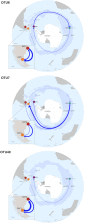Exploring the Microdiversity Within Marine Bacterial Taxa: Toward an Integrated Biogeography in the Southern Ocean
- PMID: 34335536
- PMCID: PMC8317501
- DOI: 10.3389/fmicb.2021.703792
Exploring the Microdiversity Within Marine Bacterial Taxa: Toward an Integrated Biogeography in the Southern Ocean
Abstract
Most of the microbial biogeographic patterns in the oceans have been depicted at the whole community level, leaving out finer taxonomic resolution (i.e., microdiversity) that is crucial to conduct intra-population phylogeographic study, as commonly done for macroorganisms. Here, we present a new approach to unravel the bacterial phylogeographic patterns combining community-wide survey by 16S rRNA gene metabarcoding and intra-species resolution through the oligotyping method, allowing robust estimations of genetic and phylogeographic indices, and migration parameters. As a proof-of-concept, we focused on the bacterial genus Spirochaeta across three distant biogeographic provinces of the Southern Ocean; maritime Antarctica, sub-Antarctic Islands, and Patagonia. Each targeted Spirochaeta operational taxonomic units were characterized by a substantial intrapopulation microdiversity, and significant genetic differentiation and phylogeographic structure among the three provinces. Gene flow estimations among Spirochaeta populations support the role of the Antarctic Polar Front as a biogeographic barrier to bacterial dispersal between Antarctic and sub-Antarctic provinces. Conversely, the Antarctic Circumpolar Current appears as the main driver of gene flow, connecting sub-Antarctic Islands with Patagonia and maritime Antarctica. Additionally, historical processes (drift and dispersal limitation) govern up to 86% of the spatial turnover among Spirochaeta populations. Overall, our approach bridges the gap between microbial and macrobial ecology by revealing strong congruency with macroorganisms distribution patterns at the populational level, shaped by the same oceanographic structures and ecological processes.
Keywords: Antarctic Circumpolar Current; Antarctic Polar Front; Microbial Conveyor Belt; Minimum Entropy Decomposition; Southern Ocean; Spirochaeta; microdiversity; phylogeography.
Copyright © 2021 Schwob, Segovia, González-Wevar, Cabrol, Orlando and Poulin.
Conflict of interest statement
The authors declare that the research was conducted in the absence of any commercial or financial relationships that could be construed as a potential conflict of interest.
Figures





Similar articles
-
Marked phylogeographic structure of Gentoo penguin reveals an ongoing diversification process along the Southern Ocean.Mol Phylogenet Evol. 2017 Feb;107:486-498. doi: 10.1016/j.ympev.2016.12.003. Epub 2016 Dec 8. Mol Phylogenet Evol. 2017. PMID: 27940333
-
Open-ocean barriers to dispersal: a test case with the Antarctic Polar Front and the ribbon worm Parborlasia corrugatus (Nemertea: Lineidae).Mol Ecol. 2008 Dec;17(23):5104-17. doi: 10.1111/j.1365-294X.2008.03970.x. Epub 2008 Nov 4. Mol Ecol. 2008. PMID: 18992005
-
Origin, diversity, and biogeography of Antarctic scale worms (Polychaeta: Polynoidae): a wide-scale barcoding approach.Ecol Evol. 2022 Jul 17;12(7):e9093. doi: 10.1002/ece3.9093. eCollection 2022 Jul. Ecol Evol. 2022. PMID: 35866013 Free PMC article.
-
Microdiversity shapes the traits, niche space, and biogeography of microbial taxa.Environ Microbiol Rep. 2017 Apr;9(2):55-70. doi: 10.1111/1758-2229.12523. Epub 2017 Mar 13. Environ Microbiol Rep. 2017. PMID: 28185400 Review.
-
Human-mediated dispersal of terrestrial species between Antarctic biogeographic regions: A preliminary risk assessment.J Environ Manage. 2019 Feb 15;232:73-89. doi: 10.1016/j.jenvman.2018.10.095. Epub 2018 Nov 21. J Environ Manage. 2019. PMID: 30468960 Review.
Cited by
-
Rhodobacteraceae dominate the core microbiome of the sea star Odontaster validus (Koehler, 1906) in two opposite geographical sectors of the Antarctic Ocean.Front Microbiol. 2023 Sep 20;14:1234725. doi: 10.3389/fmicb.2023.1234725. eCollection 2023. Front Microbiol. 2023. PMID: 37799611 Free PMC article.
-
Habitat specificity modulates the bacterial biogeographic patterns in the Southern Ocean.FEMS Microbiol Ecol. 2024 Oct 25;100(11):fiae134. doi: 10.1093/femsec/fiae134. FEMS Microbiol Ecol. 2024. PMID: 39363207 Free PMC article.
-
Host specialization and spatial divergence of bacteria associated with Peltigera lichens promote landscape gamma diversity.Environ Microbiome. 2024 Aug 5;19(1):57. doi: 10.1186/s40793-024-00598-x. Environ Microbiome. 2024. PMID: 39103916 Free PMC article.
-
Unveiling the co-phylogeny signal between plunderfish Harpagifer spp. and their gut microbiomes across the Southern Ocean.Microbiol Spectr. 2024 Apr 2;12(4):e0383023. doi: 10.1128/spectrum.03830-23. Epub 2024 Mar 5. Microbiol Spectr. 2024. PMID: 38441978 Free PMC article.
-
Sargasso Sea bacterioplankton community structure and drivers of variance as revealed by DNA metabarcoding analysis.PeerJ. 2022 Feb 28;10:e12835. doi: 10.7717/peerj.12835. eCollection 2022. PeerJ. 2022. PMID: 35251777 Free PMC article.
References
-
- Adamack A. T., Gruber B. (2014). PopGenReport: simplifying basic population genetic analyses in R. Methods Ecol. Evol. 5 384–387.
-
- Almasia R., Carú M., Handford M., Orlando J. (2016). Environmental conditions shape soil bacterial community structure in a fragmented landscape. Soil Biol. Biochem. 103 39–45. 10.1016/j.soilbio.2016.08.004 - DOI
-
- Arkhipkin A. I., Middleton D., Sirota A., Grzebielec R. (2004). The effect of Falkland current inflows on offshore ontogenetic migrations of the squid Loligo gahi on the southern shelf of the Falkland Islands. Estuar. Coast. Shelf Sci. 60 11–22. 10.1016/j.ecss.2003.11.016 - DOI
-
- Assis J., Tyberghein L., Bosch S., Verbruggen H., Serrão E. A., De Clerck O. (2018). Bio−ORACLE v2. 0: extending marine data layers for bioclimatic modelling. Glob. Ecol. Biogeogr. 27 277–284. 10.1111/geb.12693 - DOI
-
- Astorga A., Oksanen J., Luoto M., Soininen J., Virtanen R., Muotka T. (2012). Distance decay of similarity in freshwater communities: do macro−and microorganisms follow the same rules? Glob. Ecol. Biogeogr. 21 365–375. 10.1111/j.1466-8238.2011.00681.x - DOI
LinkOut - more resources
Full Text Sources
Research Materials
Miscellaneous

